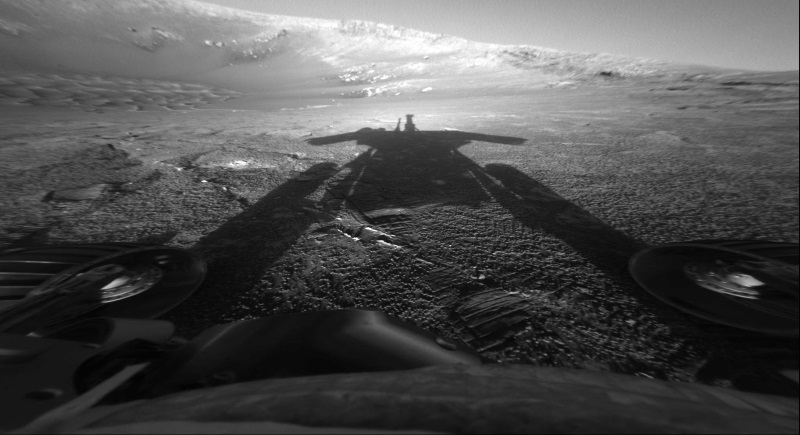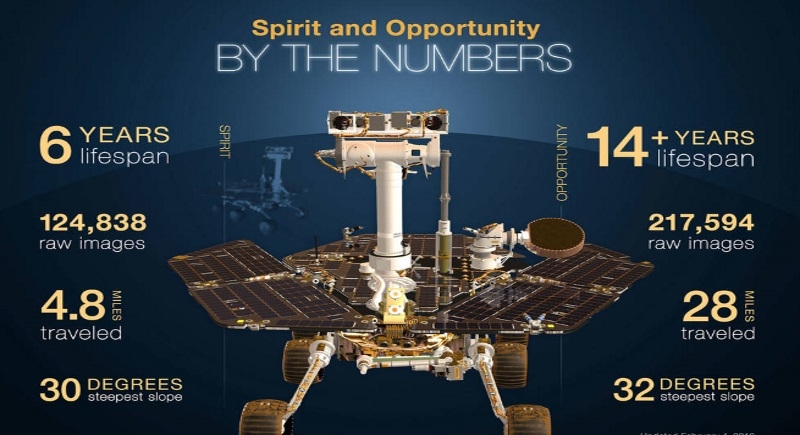NASA said goodbye to Opportunity rover after the last attempt to call

Washington, Feb 14: After 8 months of silence from Opportunity from Mars, NASA said goodbye to the Mars rover that was supposed to last just 90 days on the Red Planet but stuck it out for 15 years in its place.
One of the most successful and enduring feats of interplanetary exploration, NASA's Opportunity rover mission is at an end after almost 15 years exploring the surface of Mars and helping lay the groundwork for NASA's return to the Red Planet.
The Opportunity rover stopped communicating with Earth when a severe Mars-wide dust storm blanketed its location in June 2018. After more than a thousand commands to restore contact, engineers in the Space Flight Operations Facility at NASA's Jet Propulsion Laboratory (JPL) made their last attempt to revive Opportunity Tuesday, to no avail. The solar-powered rover's final communication was received June 10.
"It is because of trailblazing missions such as Opportunity that there will come a day when our brave astronauts walk on the surface of Mars," said NASA Administrator Jim Bridenstine. "And when that day arrives, some portion of that first footprint will be owned by the men and women of Opportunity, and a little rover that defied the odds and did so much in the name of exploration."
"For more than a decade, Opportunity has been an icon in the field of planetary exploration, teaching us about Mars' ancient past as a wet, potentially habitable planet, and revealing uncharted Martian landscapes," said Thomas Zurbuchen, associate administrator for NASA's Science Mission Directorate. "Whatever loss we feel now must be tempered with the knowledge that the legacy of Opportunity continues — both on the surface of Mars with the Curiosity rover and InSight lander — and in the clean rooms of JPL, where the upcoming Mars 2020 rover is taking shape."

Opportunity landed in the Meridiani Planum region of Mars on Jan. 24, 2004, seven months after its launch from Cape Canaveral Air Force Station in Florida. Its twin rover, Spirit, landed 20 days earlier in the 103-mile-wide (166-kilometer-wide) Gusev Crater on the other side of Mars. Spirit logged almost 5 miles (8 kilometers) before its mission wrapped up in May 2011.
From the day Opportunity landed, a team of mission engineers, rover drivers and scientists on Earth collaborated to overcome challenges and get the rover from one geologic site on Mars to the next.
Drive along with NASA’s Opportunity Mars rover and hear the voices of scientists and engineers behind the mission. Designed to run for 90 days, the exploration spanned more than 15 years from 2004 to 2019. Along the way, it discovered definitive proof of liquid water on ancient Mars and set the off-world driving record.
Mars exploration continues unabated. NASA's InSight lander, which touched down on Nov. 26, is just beginning its scientific investigations. The Curiosity rover has been exploring Gale Crater for more than six years. And, NASA's Mars 2020 rover and the European Space Agency's ExoMars rover both will launch in July 2020, becoming the first rover missions designed to seek signs of past microbial life on the Red Planet.